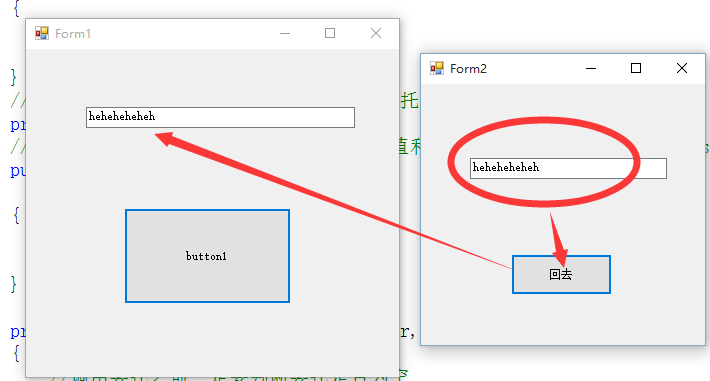说明(2017-11-23 19:31:53):
1. 关于委托和窗体传值,一下午在网上查阅了大量资料,基本就是CSDN的论坛和博客园的文章,大家都在举例子,烧水、鸿门宴,看评论说还看到过沙漠足球的,真是跪了。。
2. 最后还是看一直了CZ杨洪波三层里的窗体传值,照着把代码写出来的,其实我第一次听说“窗体传值”这个概念,就是听得杨洪波讲的这个。
3. 最关键的一步,就是把字符串和方法,作为Form2的参数,传给Form2。
4. 虽然前面做了好几个委托的例子,也知道委托怎么写,但是这个传值就是不知道怎么写,一开始一直以为要把委托写在Form1里,谁知道是写在Form2里的!
5. 蒋坤是让写一个点击改变Form1的背景颜色,应该比窗体传值简单,或者说是一个套路,我试一下。
Form1:
using System; using System.Collections.Generic; using System.ComponentModel; using System.Data; using System.Drawing; using System.Linq; using System.Text; using System.Windows.Forms; namespace _07_窗体传值 { public partial class Form1 : Form { public Form1() { InitializeComponent(); } private void button1_Click(object sender, EventArgs e) { Form2 f2 = new Form2(tb1.Text, DoSth); f2.Show(); } //这个方法通过Form2的构造函数传过去 public void DoSth(string str) { tb1.Text = str; } } }
Form2:
using System; using System.Collections.Generic; using System.ComponentModel; using System.Data; using System.Drawing; using System.Linq; using System.Text; using System.Windows.Forms; namespace _07_窗体传值 { //委托要定义在Form2里面 public delegate void MyDel(string str); public partial class Form2 : Form { public Form2() { InitializeComponent(); } //声明一个委托变量,接收Form2传过来的委托 private MyDel _mdl; //精髓就在于Form2的构造函数,把Form1的值和DoSth方法传到Form2里面,this是为了继承Form2窗体,省去了InitializeComponent()这一行 public Form2(string str, MyDel mydel) : this() { tb2.Text = str; this._mdl = mydel; } private void button1_Click(object sender, EventArgs e) { //调用委托之前一定要判断委托是否为空 if (_mdl != null) { _mdl(tb2.Text); this.Close(); } } } }
效果是这样婶儿的:
首先:

其次:




 浙公网安备 33010602011771号
浙公网安备 33010602011771号